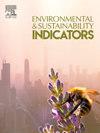US CO2 emissions and IPCC components: Evidence of persistence using fractional integration
IF 5.4
Q1 ENVIRONMENTAL SCIENCES
引用次数: 0
Abstract
This paper investigates the persistence of CO2 emissions in the US and per Intergovernmental Panel on Climate Change (IPCC) category contribution, evaluating its persistence across time (1970–2022). The structure of the integration factor and major structural breaks are examined to determine the degree of persistence across sectors and to assess policy effectiveness. Empirical results show clear evidence of persistence and non-mean reversion patterns in the long-term CO2 emissions in all sectors; though, log-data show weak mean reversion across global bioenergetic emissions and fossil manufacturing-civil airline emissions. Moreover, structural breaks results suggest that these breaks are mostly related to economic shocks rather than to environmental policies. Excepting Road and Transportation, all IPCC sectors show decreasing emission patterns since 2000. Thus, this persistent profile would suggest that emissions from these sectors would maintain this decreasing pattern in the future. However, Road and Transportation (29 % of total emissions) exhibit a different growing pattern, that suggests further increases if no additional measures are taken. Therefore, to accomplish IPCC commitments, more efforts are recommended with a special focus in the Road and Transportation sector to change the long-term US CO2 emission pattern.
美国二氧化碳排放和IPCC成分:使用分数积分的持久性证据
本文研究了美国二氧化碳排放的持续性以及各政府间气候变化专门委员会(IPCC)类别贡献,评估了其跨时间(1970-2022)的持续性。研究整合因素的结构和主要结构性断裂,以确定跨部门的持续程度,并评估政策有效性。实证结果表明,所有部门的长期二氧化碳排放均存在持续性和非均值回归模式;然而,对数数据显示,全球生物能源排放和化石燃料制造业-民用航空公司排放的均值回归较弱。此外,结构性断裂的结果表明,这些断裂主要与经济冲击有关,而与环境政策无关。自2000年以来,除道路和运输外,IPCC所有部门的排放模式均呈下降趋势。因此,这种持续的情况表明,这些部门的排放量在未来将保持这种减少的趋势。然而,道路和运输(占总排放量的29%)表现出不同的增长模式,这表明如果不采取额外措施,排放量将进一步增加。因此,为了实现IPCC的承诺,建议加大力度,特别关注道路和运输部门,以改变美国长期的二氧化碳排放模式。
本文章由计算机程序翻译,如有差异,请以英文原文为准。
求助全文
约1分钟内获得全文
求助全文
来源期刊

Environmental and Sustainability Indicators
Environmental Science-Environmental Science (miscellaneous)
CiteScore
7.80
自引率
2.30%
发文量
49
审稿时长
57 days
 求助内容:
求助内容: 应助结果提醒方式:
应助结果提醒方式:


